RogueRose
International Hazard
    
Posts: 1593
Registered: 16-6-2014
Member Is Offline
|
|
Quartz tubes (140mm x 13mm) from halogen lamp -also with tungsten element running through it - ketene lamp maybe?
I came across some odd halogen bulbs some time ago, they are marked as 165v and 1500w, they are 7.25" ~ 165mm long (including connectors) and 1/2" of
12.7mm wide. No one in the electronics forum could figure out what it was used for as this is a really odd voltage and some thought it may be a
heating element in an oven. So, I have lots of these and can get LOTS for not much (local surplus shop).
I've tested the glass and it is quartz of what seems to be high quality. A glass blower tested melting it and it took his biggest torch at full to
get it just soft enough to mould.
I cut/drilled the quartz with a diamond bit (dremel) and it is SO much nicer to work with than glass. You can tell you are working with a solid
compound (SiO2) crystal structure vs an amalgam of many compounds. The quartz gives off light when being cut with a diamond bit, same as white quartz
rock. Drilling and cutting are easy.
As quartz has a MP of near 3100F it can withstand a lot and it is super resistant to chemicals. I've seen quartz combustion tubes and was wondering
what those are used for. also, I was wondering if this could be used to pass gas through while either using the tungsten filament or a nicrome
replacement. The hole can be made to fit a glass tube very snugle and even melt a tube around the opening for an even better seal.
This is what they look like.
 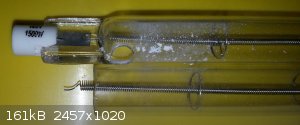
|
|
|
Chemetix
Hazard to Others
  
Posts: 375
Registered: 23-9-2016
Location: Oztrayleeyah
Member Is Offline
Mood: Wavering between lucidity and madness
|
|
These tubes can be made from a variety of glasses, some are aluminosilicate glass which is a high performance borosilicate in terms of melting point,
hardness and co-efficient of expansion; Schott 8250 and Schott 8252 are often seen as "quartz halogen" tubes. They seal molybdenum nicely; the little
metal ribbon at the ends is molybdenum.
GE 214 is a true quartz, and so is Corning 7980, these are often seen in lighting applications and might be what the above sample is made from.
If you are going to work the glass with a diamond Dremel tool, use the finest grit you can get and do it under running water. It chips badly with
anything but a fine grade of diamond.
I use a 76-grit tool for boro cutting and quartz comes up looking a little rough on the same tool.
I have found that if you try to join anything to the tube you'll need to flush or purge with argon to prevent the filament from oxidising at the
working temp.
...not too bad a job with the cut and hole by the way!
|
|
|
Morgan
International Hazard
    
Posts: 1694
Registered: 28-12-2010
Member Is Offline
Mood: No Mood
|
|
I saw this and a live support question link. Kind of looks like your bulb with 4 metal support rings. What's the other word above TECH on one end of
the insulator? 1500 watts is a fair amount of light. Seems rather expensive.
https://www.interlight.biz/light-bulb/OSRAM-SYLVANIA-DVX
|
|
|
clearly_not_atara
International Hazard
    
Posts: 2788
Registered: 3-11-2013
Member Is Offline
Mood: Big
|
|
There are many interesting gas-tube reaction products which are not so scary as ketene... SiHCl3 comes to mind.
It is always a little surprising that people want to make ketene when cyanogen chloride is about equally bad (if not safer), less volatile, easily
made at room temperature and can be used for all the same things (considering acid-catalyzed conversion to cyanuric chloride). I presume the reaction
of ferrocyanides with chlorine should be effective.
|
|
|
RogueRose
International Hazard
    
Posts: 1593
Registered: 16-6-2014
Member Is Offline
|
|
it says "Bron" above TECH. All I can say for that link is WOW! That is pricey! The place that has these had a few cases of them and many of the
ones on the shelves had a broken filament. They could be a work light or for industrial lighting. I've seen halogen ovens and maybe that could be a
use for these - 1500w is plenty for a small/portable oven.
I forgot to mention that I heated this with a blowtorch for about a minute and it was glowing orange/pink then plunged it into room temp water and it
was fine - just hissed for about a second.
What made me think it was all quartz was the reaction with the diamond - the light emitted from the grinding tip.
As far as the ketene, I don't know a lot about it but have seen some setups and remembered that it seemed like a lightbulb type setup - so this made
me think of that - just thought it MAY be useful in a similar fashion or similar experiment.
The cutting was extremely easy compared to other glasses I've cut and thought it was probably because it was quartz.
I was thinking of using some of these as test tubes by cutting the one end off (as seen) and pulling the wire off. I know there may be a small part
of metal left in the base but IDK what I can do about that. Maybe heat it enough to get soft then pinch it a little just above the metal?
I cut as close to the end as possible in this pic. It could be smoothed out but not necessary until I know if it will be used.
[Edited on 7-6-2017 by RogueRose]
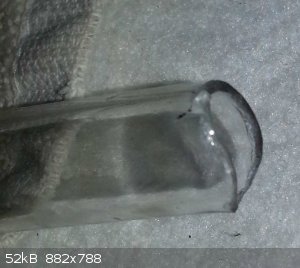
|
|
|
Chemetix
Hazard to Others
  
Posts: 375
Registered: 23-9-2016
Location: Oztrayleeyah
Member Is Offline
Mood: Wavering between lucidity and madness
|
|
An oxy propane brazing tip #12 would work. just use some heavy shade goggles to see what you're doing.
|
|
|
Morgan
International Hazard
    
Posts: 1694
Registered: 28-12-2010
Member Is Offline
Mood: No Mood
|
|
Some tidbits and possibly this type of lamp. If you click on the little green i dots they have some informative "glossary of terms" explanations like
the burn position hor I guess for horizontal.
notes: ANSI spec sheet also refers to ANSI-C78.260
graphic arts lamp
d.hours: 600 http://www.donsbulbs.com/cgi-bin/r/d.pl/design_hours.html
http://www.donsbulbs.com/cgi-bin/r/b.pl/1500-iq~mac-beth.htm...
"Thanks to you; donsbulbs is the world's largest resource of bulb data and cross-referencing."
You mentioned "they are 7.25" ~ 165mm long (including connectors)" but 7.25inches = 184.15mm and on Don's bulbs it's listed as 189mm.
Anyway maybe it's your bulb, a graphic arts lamp.
[Edited on 7-6-2017 by Morgan]
|
|
|
NedsHead
Hazard to Others
  
Posts: 409
Registered: 9-12-2014
Location: South Australia
Member Is Offline
Mood: No Mood
|
|
they look similar to the bulbs used in paint curing booths
|
|
|
violet sin
International Hazard
    
Posts: 1480
Registered: 2-9-2012
Location: Daydreaming of uraninite...
Member Is Offline
Mood: Good
|
|
We use the smaller 500w guys all the time in drywall. Not for working visibility so much as forcing a hard shadow on imperfections when doing
smoothwall jobs. Couple going right now. While we do use double head lamps, 2@ 500w = 1000w, I have never seen one single bulb larger than 500w.
Those things get f@$&#*g hot, some times used to dry patch spots faster. Most the time just burn your knuckles, wrists and forearms..
Been a decent source for fillaments, reliable enough to keep collecting with out getting discouraged.
|
|
|
Fluorite
Hazard to Others
  
Posts: 138
Registered: 26-12-2018
Location: United Arab Emirates
Member Is Offline
|
|
So I want to make a diy condenser and I bought this glass tube heating element
Can you please tell me why is it reflective? there's no coat on the outside!
is it safe to distill nitric acid? I'm asking for what may happen if HNO3 dissolve the coating if any toxic metal or idk in this I don't toxic salts
 pls don't judge me pls don't judge me
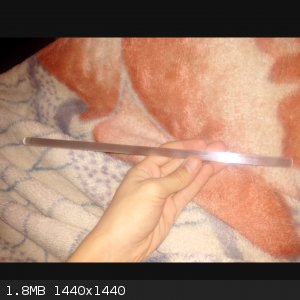 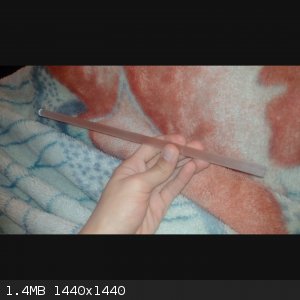 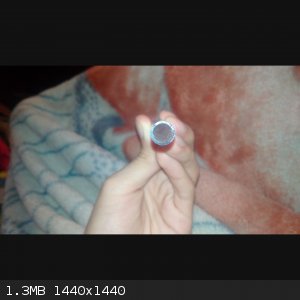
|
|
|
Fluorite
Hazard to Others
  
Posts: 138
Registered: 26-12-2018
Location: United Arab Emirates
Member Is Offline
|
|
Quick Google search I think there's a "ceramic" coating
|
|
|
Ubya
International Hazard
    
Posts: 1247
Registered: 23-11-2017
Location: Rome-Italy
Member Is Offline
Mood: I'm a maddo scientisto!!!
|
|
mh i don't think so, if you look closely it isn't just a coating, the entire thing has that "texture".
| Quote: |
The opaque quartz tubes comes from quartz sands of high purity when reduced to a molten state at a temperature of approximately 2000° C. The high
temperature produces a vitreous material characterized by the presence of a multitude of gaseous micro-bubbles. These bubbles diffract light, giving
the material its opacity. The term opaque silica is mainly used for molded or centrifuged parts, while the product obtained by drawing is normally
referred to as translucent. Opaque quartz glass, due to the scattering of light in the micropores, is a very good thermal insulator, blocks infrared
(IR) radiation, has a microporous structure with a high density and smooth surface. It is opaque, it can be used at high temperatures (constant
operating temperature up to 1100 ° C) and chemically aggressive environments. |
---------------------------------------------------------------------
feel free to correct my grammar, or any mistakes i make
---------------------------------------------------------------------
|
|
|
yobbo II
National Hazard
   
Posts: 764
Registered: 28-3-2016
Member Is Offline
Mood: No Mood
|
|
It is quartz glass.
The quarz is not clear, I don't know why.
Yob
|
|
|